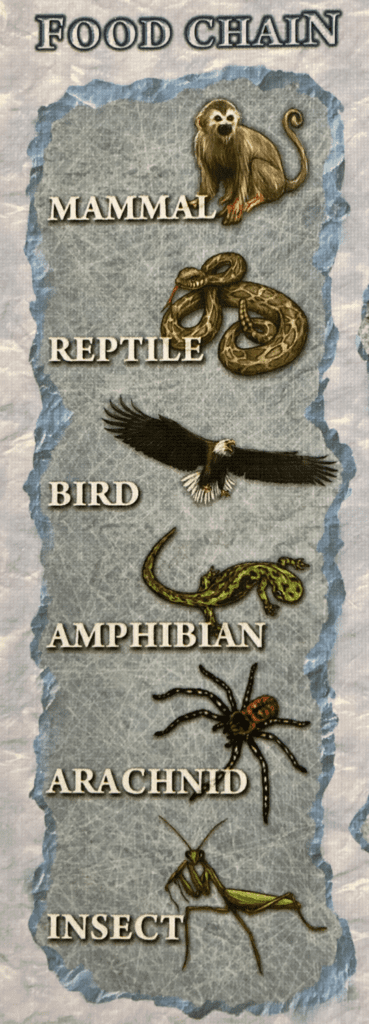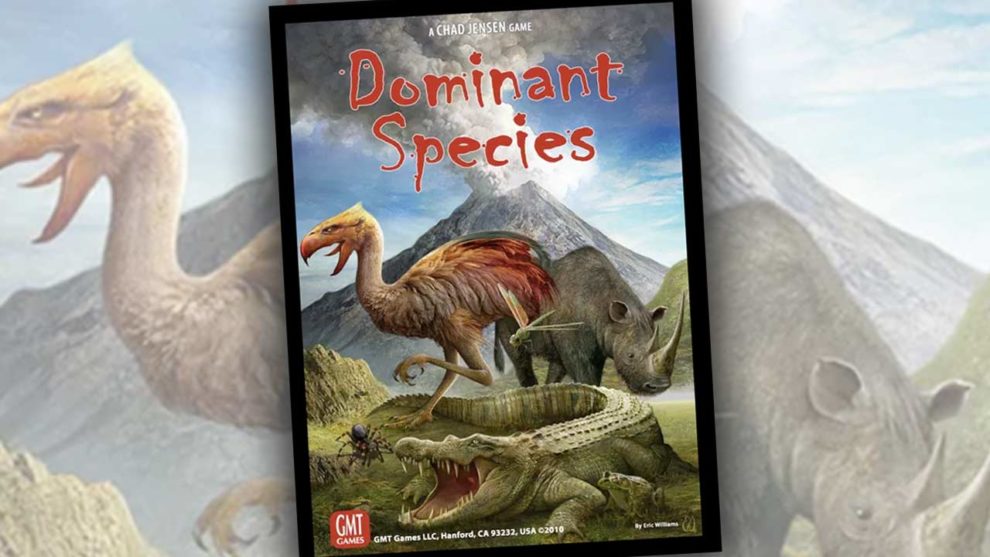What is Dominant Species?
Dominant Species (DS) is a game of adaptation and survival in the face of an encroaching ice age. Players take on the role of 1 of 6 major animal classes: mammals, reptiles, birds, amphibians, arachnids, and insects. They select and execute actions to improve their animals’ chances of survival and dominance over other species. The player who accumulates the most victory points (VPs) when the ice age reaches its zenith wins and is crowned the dominant species.

Each game turn is divided into 3 phases. The first of these is the Planning Phase, where players take turns placing an Action Pawn (AP) on an empty action space on the board’s Action Display. In the Execution Phase, starting from the top action and working down and left-to-right, players take actions removing their APs as they do so. Finally, during the Reset Phase, players check if any species has gone extinct, determine which player has the greatest survival, and then prepare the board for the next turn.
The playing area consists of hexagonal spaces on which players can place Wanderlust Tiles depicting different types of terrain. During the game, players will place their species cubes onto these tiles, as well as Element disks representing different food sources on the corners of tiles. Players will also put down Tundra tiles on top of terrain to represent the growing glaciation of the planet. How species cubes, Element disks, and Tundra tiles are placed will impact how VPs are awarded as we shall see momentarily.

Each player also has an animal display. Besides summarizing what each of the action spaces does, it shows what food sources the animal can use to survive. There are 6 such spaces, 2 of which are pre-printed. The other 4 spaces can be populated with Element disks of the same or different types of food.

Majority vs. Dominance

Before getting to the actions, we need to distinguish between majority and dominance. The player who has the most species cubes on a tile has the majority, but not necessarily dominance. Dominance is determined by comparing the Element disks on the tile with the Elements that animal has on their display. For each Element on the tile, the player scores dominance equal to the number of those Elements on their display.
For example, let’s suppose a forest tile has 2 grubs, 1 seed, and 1 grass on it. The Reptile player has 2 grass and 1 grub on their display, and 5 species cubes on the forest tile. The Insect player has 2 grubs, 1 meat, and 1 seed on their display, and 6 species cubes on the forest tile. The Insect player has the majority, but who has dominance? The Reptile player would score 1 point for each of the 2 grubs present for 2 points, plus 2 points for the 1 grass present, for a total of 4 points. The Insect player would score 2 points for each of the 2 grubs present for 4 points, plus 1 point for the single seed, for a total of 5 points. Thus, the Insect player also has dominance and could place one of their dominance pawns on the tile.
Note that there is no meat present on the forest tile, so it doesn’t provide any points to the Insect player. If there was no seed present on the tile, then both the players would tie each other at 4 points. In the case of ties, the player higher in food chain order, the Reptiles, would have dominance.
So why does this matter? We’ll see when we discuss the Dominance Action.
Action Display

The Action Display is the heart of the game. There are 12 different types of Action spaces available at the start of each turn. Each action type has 1 or more action spaces indicated with “eyeball” symbols. This is where players place their APs during the Planning Phase. Then, during the Execution Phase, the action spaces are resolved in sequential order from top to bottom, and from left to right.
The first action, Initiative, is used to manipulate the turn order. The player who places their AP here can move their animal’s Initiative Marker one space to the left and thus move up in turn order the next turn. Then, instead of removing their AP, they can place it on any empty action space on the board, essentially getting an extra action this turn.
The following five actions (Adaptation, Regression, Abundance, Wasteland and Depletion) are all about obtaining, placing, and eliminating Element disks from both earth and players’ animal displays. Note the arrows running from some actions to those below them. These indicate that unused Elements will slide down to the action below during the Reset Phase, thus giving players advanced warning of which Elements might be in jeopardy next turn. Selecting which Elements to add to your display and board can impact who will have dominance on each terrain tile, so choose wisely.
The next five actions (Glaciation, Speciation, Wanderlust, Migration, and Competition) affect the state of the earth and the species inhabiting it. Glaciation adds Tundra tiles and represents the spread of the ice across the planet. Doing so wipes out all but 1 of each species present. Speciation is used to place new species cubes from your gene pool on the earth. Wanderlust adds new terrain tiles, and Migration permits players to move species to adjacent tiles. Finally, Competition provides a mechanism for players to eliminate other players’ species cubes. Not only will these five actions impact who has majority and dominance, but certain actions—Glaciation and Wanderlust—can grant players VPs based on the quantity of existing tiles adjacent to the one placed. The number of VPs awarded is determined using the Bonus Points Table printed on the board.
The final action is Dominance and is perhaps the most important in the game. Each terrain tile has 3 numbers printed on them. These are the (VPs) that are awarded to each player who has species cubes present on that tile when a Dominance action is resolved. The number of VPs each player receives is based on the number of species they have on that tile, from most to least. Continuing with our earlier example, that means the Insect player would gain 5 VPs and the Reptile player would gain 3 VPs. However, regardless whose AP is being resolved, the player who has dominance gets to select and play one of the face-up Dominance Cards. These cards can have profound effects, so it behooves players to have both majority and dominance.

After all actions have been taken, all endangered species go extinct and are eliminated. A species is endangered if the tile it is on does not contain any Element disks that match those on their animal display. Then, the player who has the most species on Tundra tiles is given the Survival Card. This is a big deal because it immediately awards that player with bonus VPs based on the total quantity of Tundra tiles on earth. For example, if there are 7 Tundra tiles, that player gets a whopping 28 VPs.

Thoughts on Game Play and Strategy
The rules allow players to either select the animal class they want to play or assign them randomly. If the former method is used, it becomes the first and arguably the most consequential decision you make. That’s because each animal class has a special ability:
- Mammals get to save one species cube from Extinction.
- Reptiles get to take one free Regression action every turn.
- Birds get to move their species cubes up to 2 tiles during a Migration action.
- Amphibians start the game with 3 pre-printed water Elements on their animal display.
- Arachnids get to take one free Competition action every turn.
- Insects get to place 1 species cube every Speciation action.
Correctly exploiting your animal’s ability can be the key to winning the game. For example, as the amphibian player, rather than increase my chances of gaining dominance by placing water Elements on the board whenever I had the chance to, I instead focused on getting the most species cubes on Tundra tiles. While this worked for me initially, that left the door open to the Bird player to use their 2-space movement allowance during Migration to jump onto many tiles I occupied, seizing the majority and in some cases dominance. It also allowed the Bird player to literally swoop onto Tundra tiles during the last few turns and score big points with the Survival card. Playing to your strength will reap rewards.
I’ve only ever seen the mechanic of first planning all your actions and then executing them in a prescribed order in one other game, Crisis. This mechanic not only drives game play, but player interaction and strategy. For instance, you must be mindful which Elements are at risk of being removed from your animal display and board each turn so you can place your APs on Regression and/or Wasteland to safeguard them. However, your opponents can block you from placing your AP in those action spaces if they get there first. Therefore, it is not unusual for players to grab the Initiative action space so they can move up in turn order and thus get to play one of their APs earlier next turn. So, unlike in many other games, this is not a “throw away” action since you not only move up in turn order but also get to reposition that AP to another empty action space and activate it later in the same turn.
At first glance, the Glaciation action may not seem that important since placing a Tundra tile will likely yield only 3 to 6 points. However, placing a Tundra tile removes all but one of each type of species cubes. Doing so could prevent one of your opponents from scoring VPs for that tile during the Dominance action, as well as being able to play a Dominance Card. True they might be able to add additional cubes to that tile with Speciation and Migration actions, but Tundra tiles only award 1 VP.
Each player begins the game with a finite number of species cubes. When placed, Tundra tiles cause species to be returned to their respective owner’s gene pool. However, Competition, Extinction, and several Dominance Cards cause them to be eliminated. As these cubes are a fixed commodity, players need to ensure they don’t put out too many too soon, and thus have none to place late in the game or leave them vulnerable to extinction. So be sure you have available food sources wherever you are as the only way to recover eliminated cubes is via the Hibernation Dominance Card.
Finally, the vast majority of VPs are scored via the Dominance action and possession of the Survival Card. Yes, points are scored by placing tiles. But this will rarely score more than 3 VPs. Thus, players should always try to grab at least one Dominance action every turn to earn VPs and have an opportunity to grab a Dominance Card. And by having a presence in many locations, players can score additional VPs on other players’ Dominance action. Furthermore, players should look for opportunities to wrestle away the Survival Card, especially late in the game when more Tundra tiles, and therefore more VPs, are at stake.
Summary
There’s a lot to like about DS. The replay value is high given the variability represented by the different animal classes, the timing of when Dominance Cards become available, and the constant changing of the board status. There is a great deal of player interaction that occurs via the action spaces each player selects and the order those actions are executed. Another plus, provided you don’t suffer from analysis-paralysis, is the plethora of decisions available via the 12 different actions. While rather simple mechanically, DS is strategically deep. There are many paths to victory, and players will need to adapt constantly to their strategy in response to what their opponents are doing. Finally, the components, while not eye-popping, are good and completely serviceable. The 20-page rulebook is laid out logically and is both clear and concise.
That said, there are some aspects of DS that some may find problematic. First, the game can get brutal. Several actions are, by design, “take that.” After all, this is a game about the competition between species and nature can be very vicious. So, if you prefer kinder, gentler, gaming experiences then DS may not be for you. Another aspect some may have difficulty with is that despite your best laid plans, they can go up in smoke suddenly due to the actions of other players. In that respect, DS is very similar to a wargame. Players will need to deal with both the fog and friction of war[1]. If that’s not your cup of tea, then find another game. Finally, the playing time can get long, especially at higher player counts.
As for me, I found the pros far outweigh the cons. Yes, I’m a wargamer, but my gaming group consists of non-wargamers, and they enjoyed it too.
[1] The fog of war refers to the ambiguous nature of information. You never have complete and fully accurate information regarding your opponent. The friction of war refers to the interaction of chance and action. You can make plans, but you can’t plan for every contingency.












Add Comment